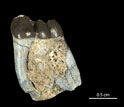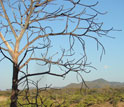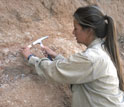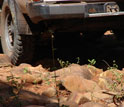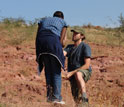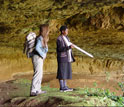News Release 13-086
Scientists Discover Oldest Evidence of Split Between Old World Monkeys and Apes
Primate fossils are 25 million years old
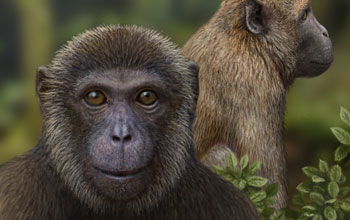
Artist's reconstruction of Rukwapithecus (front, center) and Nsungwepithecus (right).
May 15, 2013
A b-roll package is available, please contact Dena Headlee at dheadlee@nsf.gov.
This material is available primarily for archival purposes. Telephone numbers or other contact information may be out of date; please see current contact information at media contacts.
Two fossil discoveries from the East African Rift reveal new information about the evolution of primates, according to a paper published this week in the journal Nature.
Findings by scientists at Ohio University's (OU) Heritage College of Osteopathic Medicine and colleagues document the oldest fossils of two major groups of primates: the group that today includes apes and humans (hominoids) and the group that includes Old World monkeys such as baboons and macaques (cercopithecoids).
The research, funded in part by the National Science Foundation (NSF), underscores the integration of paleontological and geological approaches that are essential for deciphering complex relationships in vertebrate evolutionary history, the scientists said.
Geological analyses of the study site indicate that the finds are 25 million years old, significantly older than fossils previously documented for either of the two groups.
Both fossil discoveries uncovered primate species newly recognized by scientists. The fossils were collected from a single site in the Rukwa Rift Basin of Tanzania.
Rukwapithecus fleaglei is an early hominoid represented by a fossil mandible in which several teeth were preserved. Nsungwepithecus gunnelli is an early cercopithecoid represented by a tooth and jaw fragment.
The primates lived during the Oligocene epoch, which lasted from 34 to 23 million years ago. The research documents that the two lineages were already evolving separately during this geologic period.
"The late Oligocene is among the least sampled intervals in primate evolutionary history, and the Rukwa field area provides a first glimpse of the animals that were alive at that time from Africa south of the equator," said Nancy Stevens, Ohio University paleontologist and first author of the paper.
Co-authors are Patrick O'Connor, Cornelia Krause and Eric Gorscak of Ohio University; Erik Seiffert of SUNY Stony Brook University; Eric Roberts of James Cook University in Australia; Mark Schmitz of Boise State University; Sifa Ngasala of Michigan State University; Tobin Hieronymus of Northeast Ohio Medical University and Joseph Temu of the Tanzania Antiquities Unit.
Documenting the early evolutionary history of these groups has been elusive, as there are few fossil-bearing deposits of the appropriate age, Stevens said.
"Finding monkey and ape fossils of this age in Africa has been extremely difficult, but to find both branches in a well-dated fossil layer this old is extraordinary," said Paul Filmer, program director in NSF's Division of Earth Sciences.
"These 'oldest-yet' fossils reinforce that the Old World monkey and ape branches were already separate 25 million years ago."
Using an approach that dated multiple minerals in the rocks, geologists could determine a precise age for the specimens.
"The rift setting provides an advantage in that it preserves datable materials together with these important primate fossils," said Roberts.
Prior to these finds, the oldest fossil representatives of the hominoid and cercopithecoid lineages were recorded from the early Miocene, at sites dating millions of years younger.
"The Nsungwe Formation of Tanzania is a unique site, both geographically and chronologically, with excellent potential to yield important fossils from a vitally important time period and biogeographic area of Africa," said Carolyn Ehardt, NSF program director for biological anthropology.
"To have described two highly distinctive and completely new primates, one designated the oldest known fossil 'ape' and the other the oldest 'stem' member of the Old World monkey clade, is remarkable."
The new discoveries are particularly important for helping reconcile a long-standing disagreement between divergence time estimates derived from analyses of DNA sequences from living primates versus those suggested by the primate fossil record, Stevens said.
Studies of clock-like mutations in primate DNA have indicated that the split between apes and Old World monkeys occurred between 30 million and 25 million years ago.
"Fossils from the Rukwa Rift Basin in southwestern Tanzania provide the first real test of the hypothesis that these groups diverged so early, by revealing a novel glimpse into this late Oligocene terrestrial ecosystem," Stevens said.
The new fossils are the first primate discoveries from this precise location in the Rukwa deposits, and represent two of only a handful of known primate species from the entire late Oligocene, globally.
The scientists scanned the specimens in OU's MicroCT scanner, allowing them to create detailed three-dimensional reconstructions of the ancient specimens. The reconstructions were used for comparisons with other fossils.
"This is another great example of how modern imaging and computational approaches allow us to address more refined questions about vertebrate evolutionary history," said O'Connor.
In addition to unveiling these newly discovered primates, the Rukwa field sites have produced several other fossil vertebrate and invertebrate species new to science.
The late Oligocene interval is interesting because it provides a final snapshot of the unique species inhabiting Africa prior to the large-scale faunal exchange with Eurasia that occurred later in the Cenozoic Era, Stevens said.
A key aspect of the Rukwa Rift Basin project, she said, is the interdisciplinary nature of the research team, with paleontologists and geologists working together to reconstruct vertebrate evolutionary history in the context of the developing East African Rift System.
"Since its inception, the project has employed a multi-faceted approach to addressing a series of large-scale biological and geological questions centered on the East African Rift System in Tanzania," O'Connor said.
The research was also funded by the Leakey Foundation and the National Geographic Society.
-NSF-
-
View Video
Look back millions of years at ancient fossils in this video.
Credit and Larger Version -
A view from the scientists' field site in the Rukwa Rift Basin of southwestern Tanzania.
Credit and Larger Version -
Paleontologist Nancy Stevens at work in the Rukwa Rift Basin.
Credit and Larger Version -
Getting to the research area is often a bumpy ride in a four-wheel-drive vehicle.
Credit and Larger Version -
Anatomist Patrick O'Connor conferring with a researcher from the University of Dar es Salaam.
Credit and Larger Version -
Nancy Stevens discusses the project with Tanzanian geologist Evelyn Mbede.
Credit and Larger Version
Media Contacts
Cheryl Dybas, NSF, (703) 292-7734, email: cdybas@nsf.gov
Andrea Gibson, OU, (740) 597-2166, email: gibsona@ohio.edu
The U.S. National Science Foundation propels the nation forward by advancing fundamental research in all fields of science and engineering. NSF supports research and people by providing facilities, instruments and funding to support their ingenuity and sustain the U.S. as a global leader in research and innovation. With a fiscal year 2023 budget of $9.5 billion, NSF funds reach all 50 states through grants to nearly 2,000 colleges, universities and institutions. Each year, NSF receives more than 40,000 competitive proposals and makes about 11,000 new awards. Those awards include support for cooperative research with industry, Arctic and Antarctic research and operations, and U.S. participation in international scientific efforts.
Connect with us online
NSF website: nsf.gov
NSF News: nsf.gov/news
For News Media: nsf.gov/news/newsroom
Statistics: nsf.gov/statistics/
Awards database: nsf.gov/awardsearch/
Follow us on social
Twitter: twitter.com/NSF
Facebook: facebook.com/US.NSF
Instagram: instagram.com/nsfgov



